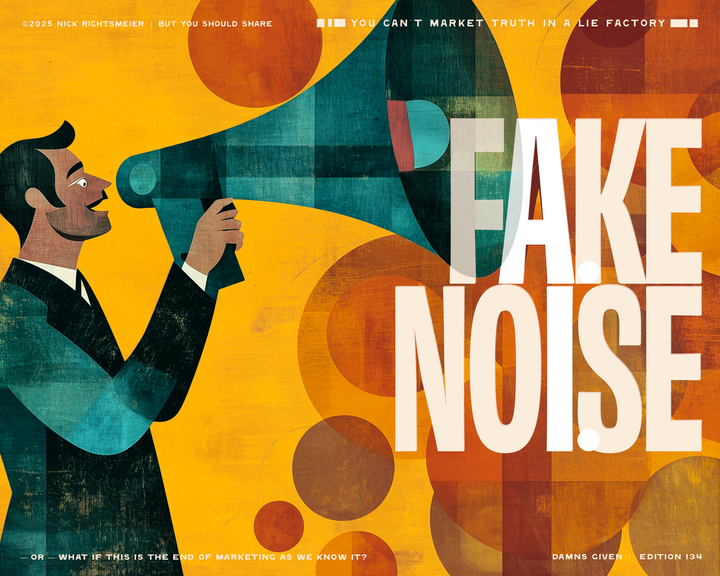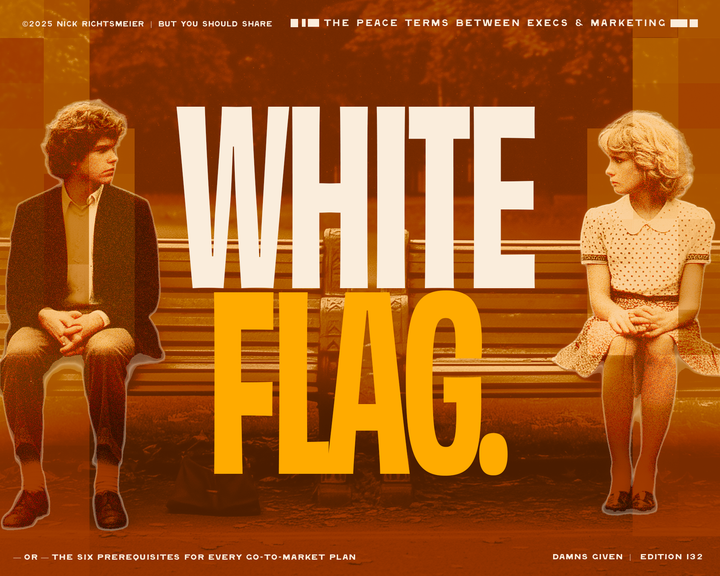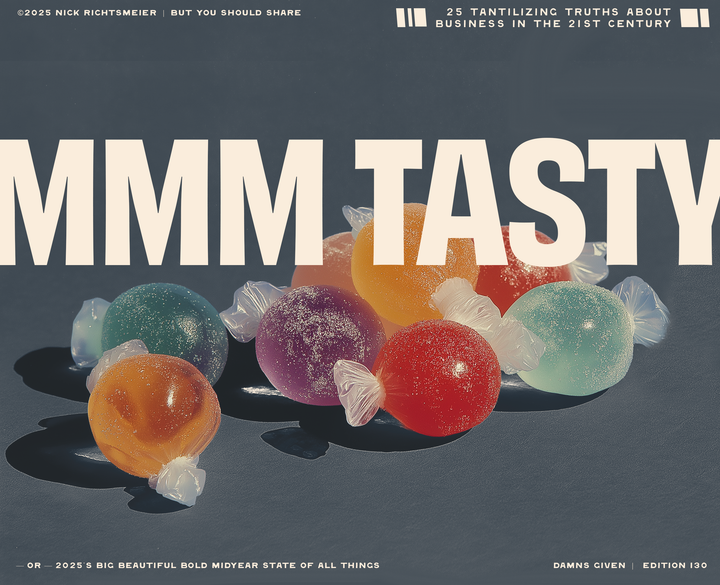How to Escape a Venomous Web
Everything you're spending time, energy, attention, or money on on the Internet should be driven by specific boundaries. It's to stop being Silicon Valley's lunch.

Edition 127 — OR — What to do on the internet now
Well, last week's edition got such stunning reviews as "A slog," and "I'm sure people have other ideas." So, you're in the right place!
The internet is a glossy ER where we're still trying to make meaning and connection, despite all obvious resistance. And yes, I dangerously keep trying to transact in ideas that challenge the illusions you, as a leader, founder, creator are being sold. Because, god help us, maybe we could build good companies and communities whose growth is powered by the trust of our neighbors, clients, and peers.
I know, I'm insane.
2025's economic remaking, the AI acceleration at Google I/O, and the total implosion of the marketing/tech professional pathway, is mature enough now, that we are due recheck the exits from the web's ability to suck time, resources, and budget from firms like yours and reset the table for trustmaking wherever its still possible.
Things I said last year—once labeled "fearmongering" and "not for us" by firms that spend nine years of future profit for each client they acquire—are now conventional wisdom.
SEOs are now publicly talking about a 70% reduction in comparable traffic on search terms, social media engagement is now saved for those willing to say unhinged things (sometimes me, I love to game the game), and yes, instructional content and case studies are now your best way to make Google and OpenAI rich.
Let's get clear on the lay of the land, and then plan our path.
First, an honest assessment of what's happening now
Who could have guessed that the moment when the Internet finally learned the Mad Men era lessons its chased for 20 years, the result would destroy the ad business as we know it. The web and its platforms have spent this century trying to become a fully operational advertising engine. All tech is adtech. All platforms, ad platforms. Any appearance of segregation between types "social media," "search," "content," etc. are superficial at best, only offering you new gateways into ways to sell visibility. This has been going on for some time.
It's been a slow burn, a la the fire underneath the proverbial frog in its blissful incremental boil. Until very recently.
Sure, we've known for years that we, your average small business, community group, and creator were the product, not the customer. This correlated with reshaping the economy where America's "prosperity" could carry on with fewer and fewer people participating. The biggest companies in the world need dramatically fewer customers.
The WSJ points out that over half of spending comes from the top 10%, with another third of the economy coming from the government. So mining small businesses, communities, and creators for their freely created content became the broadest source of uncompensated economic growth in modern history. And if we hated the platforms at the end? Who cares. We weren't really that important anyway.
Recent documentation from Google's anti-trust case showed that they knew they could make more money if search sucked, and so, they did what everyone does: follow their financial incentives.
People keep asking, "How will Google make money if it cannibalizes Google ads?" All of that sellable real estate is being moved into AI summaries while Google reorganizes its revenue model to primarily sell data and access—aka YOU—in some cases to the U.S. Government. That's why they can lay off a big chunk of their ads team.
What's the next move after turning the once front doors of the internet into stripmining operations? You need to build walls around your resources. Two hundred years ago, it was barbed wire fences and snipers around your oil fields; today, it's digital walls around your platform, so people only produce content for your extraction. Google, Meta, Microsoft, you dastardly geniuses.

In acceptable terms that agencies and marketers will happily repeat, brands were told to "create on-platform content" or "pivot to the zero-click environment" or "build your brand natively," etc., etc., etc. If the prisoners can sell the jail, all the better for those who bill per head. (or per click...)
Walling off the entrances to the web (Gen Zers often don't even know "the internet" exists beyond the apps they use), burying it in disclosure pop-ups, ads, bot traffic (now more than half of all traffic, yes to your website too), eventually the walls on these "walled gardens" connect and the entire internet is room with no entrances or exists, but YES definitely wring your hands about your website copy as we've been socialized to do for the last 20 years.
But how did they do it?
Much of this has been well known for some time, but the people who know it are rightfully concerned about what it means for the careers and companies built to service the Open Web. Tech and marketing have been the primary victims. "Learn the internet" and "Learn to code" were promised to Millennials as the one reliable way to be viable in the new digital economy. No one said they would be the first on item on the economy-eating buffet.
People get Stockholm Syndrome not just because of the rizzy swagger of their captors, but because the alternative feels like self-destruction. It falls to those of us who both understand what's wrong and how growth works beyond the internet to map a better way.
The Platforms consumed the people who made them possible with one simple thing: The Engagement Algorithm. In the early social internet (2o10s-ish) if you built a network, made connections, and added followers, you could game the Attention Economy. Value-delivery, knowledge, and connection were incentivized and productive.
Slowly, then suddenly—triggered by the TikTok phenomenon and dramatic changes to Meta's business model—"the algorithm," once a tool to help you find people you were interested in, shifted to helping you find distracts people like you.
Enter the "Engagement Algorithm."
Calibrated to the right level of agitation, random dopamine hits, topical roulette, and deep levels of privacy intrusion, the Platforms learned that the best way to keep people staring into the Black Mirror, NOT clicking on those pesky links to their websites provided by small business, communities and creators, was to go full Madison Avenue.
No facts. Just feelings. All distraction. All the time.
With "trust" (silly companies, who cares about trust?) in a multi-decade decline across every category save the military, there was no incentive to protect or build an internet infrastructure that helped companies and communities build trust with their customers and prospects. That was fun in 2010. But no one gets their own personal spacevrocket by building sidewalks and signage to small businesses.
Extraordinary economic power requires extraction. And extraction requires distraction, a game popularized by TikTok and now the norm across all the platforms.
What you should do now
Understand that there is no one path through this maze. Even the search for a "this works for everyone" solution is a hangover from the social internet's false promises. The path forward is hyper contextual. Your answer will not be your neighbor's answer.
But in an attempt to spur forward-looking action, here are four things that I think "first-movers" in almost any industry will do to free themselves from the expensive and extractive dependency on this system.
- Reconstitute your in-person networks. Growth leaders to have every client-facing person thinking about personal and professional networking and how that can be supported offline. "7000 followers" on LinkedIn means nothing.
- Localize your go-to-market. The internet incentivized everybody to pretend like they were a national or even a global business. Now we've got a big ocean full of small fish which, as we've seen, is what whales call "lunch." If you have the opportunity to be the go-to firm, provider in your city, your state, even your region, you're better off than some highly nuanced positioning that only the six people who've read more than 25 words on your website even understand.
- De-channelize. Once incentivized to be everywhere on the Internet (now you know why) brands were sucked into spending endlessly to create content for Facebook, LinkedIn, SEO, YouTube, TikTok, and the other extractors. Now you're being told to create for OpenAI. Pro tip: Don't. The closed Internet means firms should pick one or two places to be excellent, conversational, and designed for interaction. Save money, redeploy.
- Get back to first principles. Every week I speak with a brand who hasn't considered the "where to win, how to win" question in far too long. Lulled into the lie that they could outsource this kind of thing to the algorithm—to be quite direct—many executive's strategic growth muscles have atrophied substantially. It's time to go back to the gym. Build your business on purpose for a highly targeted community, with carefully designed products and services with compelling prices delivered through well-trained and inspired humans. This is the way.
Everything you're spending time, energy, attention, or money on on the Internet should be driven by some version of the above boundaries. Even more so, these boundaries should push your sales and marketing teams to touch the grass and rethink IRL in creative, context-specific ways.
Happy to talk with you if you want to dig in more.



